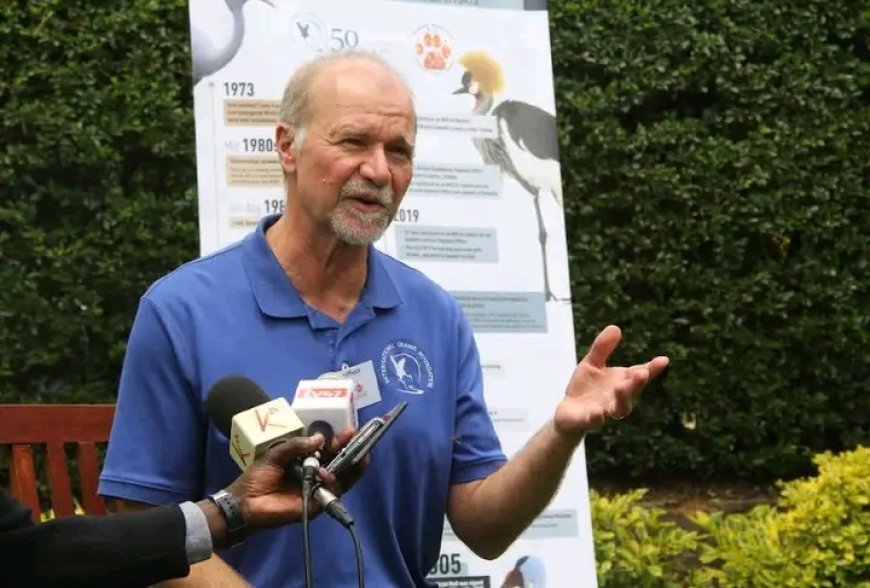Efforts to save endangered crane birds

Uasin Gishu
Saturday July 29, 2023
KNA by Ekuwam Sylvester
As the impact of climate change continues to affect the whole world, the situation poses a serious threat to the lives of crane birds whose numbers have been reported to be declining.
Following the scenario, international organizations like the USA based International Crane Foundation (ICF) and the Endangered Wildlife Trust (EWT) of South Africa have joined hands to come to the rescue of the endangered bird species especially the grey crowned cranes which are key in East Africa.
The organizations which were coincidentally established in 1973 have been in partnership for the last 30 years championing for the conservation of the wetlands to sustain the lives of the crane birds.
In an interview with the Kenya News Agency (KNA) in Eldoret during the commemoration to mark 50 years of the conservation efforts of the crane birds, the ICF President and Chief Executive Officer (CEO) Rich Beilfuss said the Wisconsin, USA based organization has been continuously working in the Africa region for the last 30 years to conserve the precious birds and their wetlands habitats for the benefit of the surrounding communities.
The ICF President pointed out that the biggest threat to the survival of the birds is habitat, how they can find a place to breed safely, raise their chicks, flock together and grow in population, adding that there are numerous threats to those habitats which include the wetlands and the surrounding areas.
The threats include human activities like farming, settlement on to the birds’ habitats, poisoning, collection of eggs and chicks from the wild by people among others.
“We know cranes are moving more into agricultural areas because those areas in the past were grasslands and wetland areas and now being farmed and so finding that balance with the local people is the big challenge,” he said.
He noted that the ICF has been working for a long time in the US with partners in Africa to try to solve the conflict between humans and the birds in order to create a positive relationship between communities especially farmers and cranes and other wildlife. Farmers may view cranes as beneficial to them by feeding on parasites which destroy crops and do not view them as destroying crops.
Rich acknowledged that the Grey Crown Crane species has been in decline across East Africa but expressed hope that through concerted efforts with communities and partners, the population will rise again in the next 5 years.
“Am very hopeful; the grey crown crane has been in decline across East Africa and we have been very worried about this bird. They are getting fewer and fewer in Uganda, Kenya and Rwanda. We have started to stabilize the population and in the next five years, we will start seeing the birds coming up a bit. That is our goal; to stop the decline and get them recovering in these areas,” said Rich.
He further said the ICF together with partners is dedicated to crane conservation to benefit communities and wetlands where they live and hence their concern about wellbeing of the cranes.
He added that in marking 50 years to recognize the key milestones in crane conservation efforts, they make long term commitments to the places where they work noting that conservation is long-term because it is about the health of the communities, the wetlands and the cranes.
“No healthy community, no healthy wetlands means no cranes. It is a very long commitment. We need to save these birds and other wildlife,” he added.
EWT CEO Yolan Friedmann lauded the 30 years partnership with the ICF in coordinating crane conservation in Southern and East Africa.
The CEO indicated that the quite common threat to a lot of the crane species is habitat change, degradation, impact of the habitat like poor quality water sources among others.
She further said that some of the birds have specific threats to them like illegal trade in some of the species and also some infrastructure has some impacts on birds like powerlines, farming fences and others.
Friedmann pointed out that The EWT and ICF are working together throughout the range of all these cranes in Africa to try to reduce some of these threats.
She revealed that they have had successes in some of the areas which has seen most of the crane species improving noting that this is not only through ICF and EWT partnership but working closely with the communities because these birds tend to live in areas with close proximity to human developments and every culture.
“It is really important that we work with communities to embrace these birds and to find alternative practices to reduce the impacts. We have great success for example looking for alternative livelihoods of communities that may be using some of the habitats for cattle grazing and for forage collection among others,” she said.
The CEO reiterated the need to work with communities to find alternatives in order to embrace these birds, adding that they have discovered that cohabitation with these birds is possible.
“Some communities also admire and adhere to the safety of the birds from personal and cultural point of view. This brings up a great desire to cohabitate with these birds in many communities; this is an alternative solution and we see birds making recovery,” said Friedmann.
She expressed worry saying in other areas, they find numbers declining forcing them to seek proper conservation measures like engaging government stakeholders to declare the birds’ habitat a protected area.
In his remarks, the East Africa Regional Manager for ICF and EWT Adalbert Aine-Omucunguzi pointed out that their focus in East Africa is the conservation of the Grey Crowned Crane which is the fastest declining crane species globally.
He stated that Kenya, Uganda and Rwanda have key populations that they are focusing on to conserve.
He decried that the population of the Grey Crowned Crane which is key in East Africa has declined by over 80 percent in the last 25 years.
He further noted that the Africa crane programme focuses on four resident species which include the Grey Crowned Crane, Black Crowned Crane which is found in Sudan, Ethiopia and West Africa, the blue crane which is found in South Africa with a small population in Namibia and the Wattled crane.
Aine-Omucunguzi said that the recent survey revealed that there are about 8000 to 10000 grey-crowned cranes in Kenya noting that the total population for East Africa is between 20,000 and 30,000 grey-crowned cranes.
Courtesy ; K. N. A
What's Your Reaction?
































































































































































































































































































